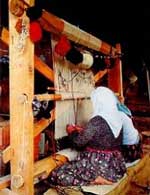Oriental Rug Construction
All Oriental Rugs are hand-knotted on a webbing formed by the warp and weft threads. Attached to the top and bottom of the loom, warp threads run vertically through the carpet. A strand of wool is tied to a pair of warp threads, forming a knot. The loose ends of the knots, which make up the body of the rug, are called pile. Weft threads run horizontally through the carpet and are used to secure the knots; one way to remember the difference between warp and weft threads is that wefts go from “weft” to right, not up and down.
Weaving Process
 The weaver sits facing a loom upon the warp threads are strung, while overhead are balls of colored yarn to be used in the rug. Reaching up, the weaver takes the end of a strand of spun wool, ties it across a pair of warp threads, and cuts free the end of the strand that is still attached to the ball of yarn. Tying and cutting the wool is done in one swift motion. So skilled are the weavers that, like the hands of a magician, their fingers move so deftly that the eye cannot follow them.
The weaver sits facing a loom upon the warp threads are strung, while overhead are balls of colored yarn to be used in the rug. Reaching up, the weaver takes the end of a strand of spun wool, ties it across a pair of warp threads, and cuts free the end of the strand that is still attached to the ball of yarn. Tying and cutting the wool is done in one swift motion. So skilled are the weavers that, like the hands of a magician, their fingers move so deftly that the eye cannot follow them.
After each row of knots has been completed, one or more weft threads are woven and and out of each warp thread. To secure them firmly in place, the weft threads and knots are beaten down with a “comb.” Any excess knotted yarn is trimmed with a large pair of scissors after each row of knots. In some areas, this may be done after the carpet has been completed. The weaver repeats this operations hundreds of times until the carpet has been completed.
Designs are formed by the arrangement of different-colored knotted yarns. The placement of each knot may be directed or specified in several different ways. The nomadic weaver, for example, is usually a woman who weaves a carpet from patterns learned from her mother or from forms unique to her own tribe. The urban or semi-urban weaver may be a woman, a man or even a child; the weaver has a section of a drawing (called a cartoon or talim from which to work. Cartoons are usually drawn to scale with a single square on the piece of paper indicating each knot. The design is colored and cut into horizontal strips, then either placed in a plastic casing for protection or mounted on a board and varnished.
Carpets are finished in one of several different ways; the warp threads may be knotted and cut to form a fringe, a kelim or a combination of the two. A kelim is a strip of cloth formed by weaving the weft threads back and forth through the warp threads. The selvedges, or the sides, of the carpet are secured and reinforced, generally by taking the last few warp threads and wrapping them tightly with an extra weft thread. Each weaving center has its own unique manner of securing the selvedge; these various processes will be discussed when the individual rugs are described.
Oriental rugs are works of art that are center stage in an interior design.

